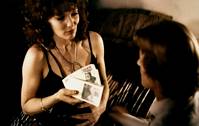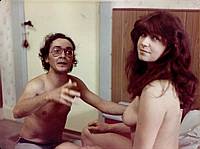
Chock-fulla-looninuts

and how to make them
copyright:
all movie photos on this page © 1974 by Harrie Verstappen
all rights reserved
copyright notice
The Psychology
What makes a photograph look like a movie still
and how to attract the many-headed monster in droves
But movie stills, after all, are made just like all photographs by much the same kind of nitwit apes. There's something more going on. This is a knack, but how to get it? I don't feel like delving too deeply into all this, but will have a fling at it.
My brother Wim, for whom I did most of my stills, once declared: "Granted, Harrie's stills are not so sharp and there's not very much color in them. But they look like movie stills. So desert sand is much sharper, and much more intensely colored, than water. Now if I'm thirsty, should I drink desert sand?"
A still has to look like a scene out of the movie.
This is the hardest part, because the two media are altogether different. Just like, on the set, paintings are often adjusted to a crooked angle to prevent them appearing at a crooked angle, you have to create the illusion it's a movie shot. For this, special measures are in order. For one, you often have to comprime the action or it will look completely different from what the public remembers or will expect to see. It's hard to describe the process exactly, also because it varies with all the different circumstances.
it's obviously posed without the characters taking any notice of the camera.
Just, mostly, like in the movie!
A still has to attract the audience.
Pretty obvious. I have always aimed at achieving this by not showing too much and mainly, by stimulating their curiosity. They must want to see more.

Willeke van Ammelrooij, Rutger Hauer
Grijpstra & de Gier
To give but one example here, Rob Houwer may have been pissed because in this shot, I had Willeke's décolleté covered by the money she extends. Well, that's where the psychology comes in. In the first place, you try to make people figure more or less like this: "Wow! what luxurious décolletage! I owe it to myself to go see that movie so I can enjoy more of this fine sight." So they buy a ticket.
And I fully agree, it's not very sharp (except for where it matters).

Pim de la Parra, Olga Zuiderhoek
Alicia
Another example. You try to make them think "What the hell is going on here?" The only course left open to them is to come up with their hard-earned cash, their ill-begotten earnings, and pay for a ticket to see that movie and find out.
Not all the same scene, please!
You must have seen those sets of stills where it seems obvious there's only one scene worth looking at in the entire movie—hardly anything else is shown. This often happens because the producer does not want to pay for a still photographer all the time and only hires him for certain production days, i.e. scenes. It also happens quite often that there is only one scene in the movie worth looking at — if that.
The scene must appear in the movie
This rule is very often sinned against. A scene, for some reason, has to be cut from the movie; but we have a very good still. "So put it in the set, already!" No way. The audience will rightfully resent this, which results in bad mouth-to-mouthing. Another thing I sometimes got entangled about in vulgar quarrels. In Zwarte Ruiter I found the publicity director of the distributor on my side here, or the disaster might have been even worse. Hard to imagine, true.
%#@&* producers
A lot of these almost-humans have given me lots of trouble. Well, it works like this:
A producer somehow and, knowing them, let's hope lawfully, acquires a script and imagines a movie based on it. So he starts producing, eventually renting a crew to grind the sorry mess out. The first results he sees are the stills. Dailies, or rushes, don't count, as they still need editing, music, sound effects and what-have-you. Now, the movie will invariably be different from what he imagined. By the time it's ready for release, he's used to that. But during the production, who gets the blame? Right.
It follows that, the better the stills, the fatter the blame.
What I feel I must tell you about producers is that most of them will make their superfluous and unneeded appearance on location every single time there's a nude scene to be shot. Then they turn out in droves. Embarrassing, right?
So you want to make movie stills?
Look into the unfathomable depths, and shiver, before you leap.
the technique
describing the means used: light, lens, camera, film
the routine
how to go about making movie stills
SEARCH this site or the Web

copyright notice
all photos, except where noted
copyright © 1974 by harrie verstappen , curaçao
all rights reserved
reproduction in any form for any purpose is prohibited
without prior consent in writing